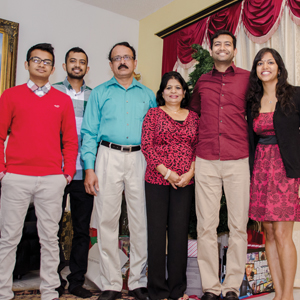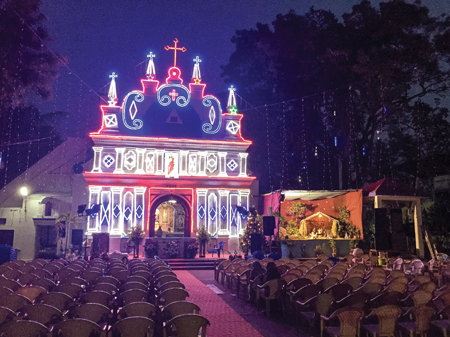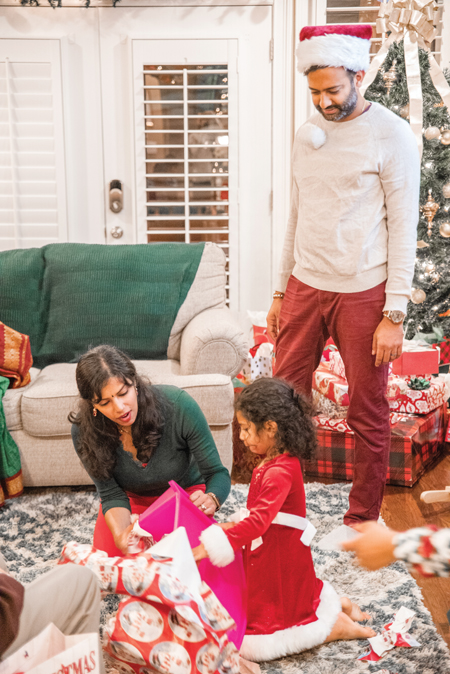Celebration: The Spirit of My Season

It was during the Christmas festivities in 2008 that the author was first exposed to Syro-Malabar Catholicism. Her definition of “Indian” changed—and today, for her interfaith family, the winter holidays are all about celebrating shared values.
[Left] The author and her husband, Jis, celebrate Christmas with his family in Holiday, Florida. The Syro-Malabar Catholic villaku (lamp) is on the right. Her family follows Christian and Hindu traditions.
My husband saunters over to the tree, donning a red velvet hat topped with a white pom pom. He selects one of the many gift bags bursting with red, green, and gold tissue paper. In an exaggerated motion, he swoops the gift above each of us seated on the couch, dangling it for a moment in front of our faces, before finally handing it to one of the little ones sitting cross-legged on the rug below. My nephew beams when he learns that he is the lucky recipient, while the rest of us are laughing at this animated scene. It’s Christmas Eve, and our extended families are exchanging gifts, embraces and, above all, the unspoken acknowledgment that what brings us together are the shared values we want to pass on to the next generation: compassion, generosity, tradition, and family.
When I was a kid in the U.S., schoolmates would ask if I celebrated Christmas. Not in any religious sense, I would respond, adding that we decorated a fake tree—a barely six-foot plastic skeleton draped in tinsel garlands—and exchanged gifts. My father would spend Thanksgiving weekend assembling the tree and hanging lights, insisting that our tree was the most beautiful. Though we were never fed Santa Claus or magical reindeer myths, I admired my parents’ spirit in not wanting us to miss out on the fun of the holiday. I distinctly remember one Christmas when they gave me my first tennis racket, one that I still use two decades later. Clearly, for me as a child, “celebrating” was marked by opening presents. Eventually, it became more about the season’s hallmarks. I looked forward to that nip in the air, the glitter and gold dressing store displays, the holiday jingles echoing for weeks, and peppermint treats dipped into luscious cups of cocoa.

[Right] While Luz Church was a familiar landmark because the author’s family stayed on Luz Church Street when in Chennai, she visited the church only after getting married.
Those instances waned in my teenage years, and I missed the Yuletide spirit when we started going to India for the winter holidays. Despite staying only a couple of blocks from the church that gave our Luz Church Street its name, I never once experienced the Christmas festivities in Chennai. While I knew that Christianity was one of the major religions practiced in India and that people in the city were attending mass and singing songs exalting the birth of Christ, I was sitting in the Madras Music Academy listening to Carnatic kirtanas in praise of Hindu deities.
All of that changed when, in my 20s, I met the man who would become my husband.
Jis, whose name refers to the Messiah himself, exposed me to Syro-Malabar Catholicism, which his family practiced. This Roman Catholic sect, recognized by the Vatican, can be traced back to the group of people who had been converted by St. Thomas the Apostle along India’s Malabar coast.
Jis and I started dating just a couple of weeks before Christmas, and my definition of “Indian” began to shift. It was no longer fitting for me to equate Indian with Hindu traditions alone. We both recognized that the mark on my forehead and the cross around his neck meant that we had been exposed to different customs while growing up, but the more we got to know one another, the more we realized that everything else—the things important to us at least—were the same.
Before the university’s Christmas break, he asked if I wanted to join him for mass on campus. I found it refreshing to see a young person care about wanting to worship together, indicating he valued religion as much as I did. My faith allowed me to worship anywhere and to accept any God as a facet or embodiment of the ones that I already knew. That mutual understanding and generosity to share traditions with one another, and the emphasis on respecting and keeping loved ones involved, above all else, has served as the foundation for everything that followed—from our approach to marriage and how we celebrate milestones, to deciding where to settle down and how we raise our kids. Never in our years together have I felt that I have had to sacrifice my own religion in doing so.
Thus, celebrating Christmas in my 30s now has been about anything but the presents.
We plan weeks in advance on where we are going to spend Christmas to ensure that we are surrounded by family. In 2016, that happened to be in Chennai, and I finally visited San Thome Church, one of only three churches in the world to house the tombs of one of Christ’s original disciples. That year, we also visited Luz Church on Christmas Eve to say a prayer.

When in Atlanta, Jis and I host Christmas Eve dinner. That night, Jis sports the Santa hat and creates a jovial atmosphere for all of us. On Christmas Day, we attend mass together as a family. I pay particular attention to the priest’s homily. The names of historic figures or the citations of religious text mean little to me. What I care about is the message, and how to translate the lessons of forgiveness, acceptance, and patience into something my three-year-old will understand.
For Jis, who has grown up with this tradition, the homilies start to sound the same, and he jokes that I am better at his religion than he. But I could say the same for him when he labors over building our Navarathri kolu every October. Therein lies the strength of our faith: we have the power of two.
[Left] Opening gifts on Christmas Eve last year as the parents watch.
As I see my peers show less interest in following formal, organized religion, I feel blessed to have found someone who also grew up in a family where faith has played a huge positive influence. I notice an increase in our peers identifying themselves as atheists, and I can understand their rationale. But now, Jis and I work twice as hard to instill faith in our kids and to pass on two religions in an era of disengagement. That means paying closer attention during his rituals and mine so we can understand and explain the significance of some customs and even observe some traditions that we would not have formally recognized before. But I don’t mind the extra effort.
So every December, Jis and I choose to double down on faith, giving in to whatever higher force brought us together. We’re better off for it, and I’m confident my kids will believe that as well. To me, that’s something worth celebrating.
Amritha Alladi Joseph, a former reporter for Gannett newspapers, The Hindu, The Gainesville Sun, Gainesville Magazine, and CNN-IBN, is now a consulting manager at EY and lives in Sandy Springs, Georgia with her husband and two children.
Enjoyed reading Khabar magazine? Subscribe to Khabar and get a full digital copy of this Indian-American community magazine.
blog comments powered by Disqus










